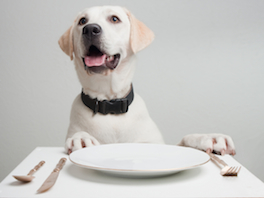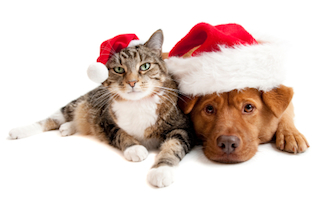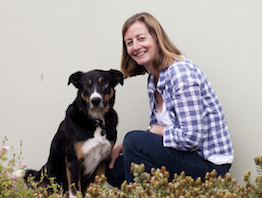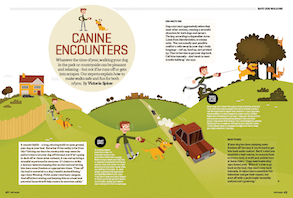Welcome to Petplan’s blog, a space where you can read up on the latest pet-news, find out interesting facts and tips about keeping your pets happy and healthy, and share your views on hot topics.
Refine articles by
clear searchHow to make a tasty Christmas dinner for your dog

We've invited writer Elaine Everest, author of hit book Canine Cuisine (£8.99, How To Books) to give us this extra-special recipe for a festive meal for your dog. Hope your dog likes it!
Ingredients
- One mug of brown rice
- One beef stock cube
- Half a small butternut squash
- Four large carrots
- One head of broccoli
- A small bunch of fresh parsley
- One tray of minced turkey
- A small carton of chicken liver
- Two cloves of garlic
- One mug of wholemeal flour
- One mug of oatmeal
- Four eggs
- Half a mug of vegetable oil
Method
- Heat your oven to 190°C or gas mark 5.
- Put the brown rice into a pan with the stock cube and cover with boiling water. Bring to the boil and simmer until the rice is cooked but not too soft.
- Meanwhile wash the vegetables. Peel the butternut squash and chop all vegetables into even-sized pieces and place into a food processor. Blitz until the vegetables resemble fine breadcrumbs before adding the parsley for a final five-second blitz.
- Place the finely chopped vegetables into a large mixing bowl along with the wholemeal flour and oatmeal. Mix together.
- Next, place the minced beef and the ox liver into the food processor and blitz along with the garlic cloves until you have a smooth paste. Add the four eggs and mix well together for several seconds.
- Add this mix to the bowl and stir together well. At this point, stir in the cooked rice and add the vegetable oil until you have a mixture that is not too runny. It is not essential to use all the oil. If the mix becomes too liquid, add a little more oatmeal to stiffen.
- Pour into a greased baking tin or two round cake tins and place into the centre of the oven. The new-style silicon bakeware is ideal for this recipe as the cake will slide away from the container with ease. Bake for 45 minutes or until a skewer comes out clean when slid into the centre of the cake. Turn out onto a cooling rack and leave to cool.
- After feeding your dog a portion of his own cake, allow his meal to go down for an hour or so before enjoying a brisk Christmas Day walk with the whole family.
Happy Christmas!
If you have a recipe you would like to share, just comment below.
Five perfect Christmas gifts for your pet

Still stuck on what to get your pet for Christmas? Try one of these!
The Meteorlight K-9 LED Ball (£12.99) is perfect for those early morning or late afternoon winter walks. The durable, water-resistant tennis-ball-sized exercise toy gives off a steady glow, comes in four colours and even floats! Most importantly, it brings an end to those lost hours spent hacking through brambles on dark January days searching for your dog's lost ball.
The ever-popular Pet Friendly Places to Stay (£9.99) by AA Publishing is back for another year. Fully updated, the 496-page guide features more than 1,000 AA-inspected hotels, B&Bs and campsites in Britain and Ireland. It's the detail that makes this guide so good, such as offering additional information on everything from exercise areas to food to whether your pet can stay in the room unattended.
Or if you'd prefer a charitable gift, the RSPCA has a lost pet bed and breakfast scheme. Just £10 pays for one night's boarding costs for a rescued animal at one of their centres, as well as a good meal. The recipient receives a personalised printed card or e-card, and the knowledge that a lost cat or dog will be having a very merry Christmas on them.
Silly, but fun, the Jolly Moggy Micro Mouse from the Cats Protection shop (£9.99) will keep your cat occupied for... well, however mischievous (or intelligent) your beloved puss is. The remote-controlled mini mouse racer is just 70mm long, runs on two AA batteries and should keep the whole family entertained well into the new year.
The Catit® Design Senses Massage Center (£11.79) offers your cat an oasis of calm and relaxation with the ultimate pampering and massage experience. It has a variety of sculpted textures and surfaces, the acu-pressure mat provides pressure-point paw massage, and the body stroke groomers stimulate face and back glands. Catnip can be added to heighten the sensory experience, while the gum stimulator massages and cleans teeth and gums.
What do you think the year's hit pet gift will be? Let us know by commenting below.
A long walk back - Toast's 20-day recovery

When a mystery illness paralysed Clare McClintock's super-fit dog, Toast, it took 20 days in intensive care to get him back on his feet. Luckily, writes Amanda Riley-Jones, Petplan was there to help. From the PetPeople magazine archive
Toast, a New Zealand Huntaway-cross Collie, is 'the most good- natured companion', according to his owner Clare McClintock. 'Last July, we walked from our home in Devon to Land's End!' But one morning in September, Toast collapsed. 'His back legs were paralysed,' she adds.
When Toast was referred to a larger practice, Clare rang Petplan. 'They were very helpful and told us we had '£4,000 of cover,' she says.
However, Toast's breathing became laboured as she took him from one specialist to another. By 6pm, he was taken into intensive care at North Somerset's Langford Small Animal Hospital.
Blood tests revealed that severe toxic shock, perhaps from ingesting pesticide, had damaged his kidneys and liver. Thankfully, Toast's paralysis didn't worsen, but he developed aspiration pneumonia and an eye ulcer.
'After the first week, Toast's bill was already up to '£4,000,' Clare explains. 'The family had to club together to pay for the rest of his treatment.' Toast had an operation to treat the eye ulcer but still needed oxygen and intensive physiotherapy.
Unfortunately, his frail eye ruptured the next week. 'The ophthalmic surgeon was prepared to try a corneal transplant, but we made the hard decision to have Toast's eye removed as it was a simpler operation,' Clare says.
Afterwards, with more massage and physiotherapy, Toast was gradually weaned off oxygen as his lungs cleared and he was able to move his legs again. He went home after 20 long days, thin and hardly able to walk. 'But he was delighted to be back and managed really well with one eye,' says Clare.
Clare massaged his joints, took him for hydrotherapy treatment and increased his walking time by five minutes a day. He's now back to his ideal weight, and loving long walks and swims in the river.
'If I hadn't had insurance, I don't know how I would have managed,' says Clare. 'Thanks to Petplan, Toast had the best possible treatment from more than 20 professionals.'
The claims
Tests and x-rays: £250
Seven days' intensive care treatment, including diagnostic imaging and radiology: £3,750
Total Petplan paid: £4,000
Toast's premium was £21.47 per month.
Seven tips for trouble-free walkies

Whatever the time of year, walking your dog in the park or countryside can be pleasant and relaxing - but not if he runs off or gets into scrapes. Victoria Spicer asks experts for advice on how to make walks safe and fun for both of you. From the PetPeople magazine archive
It sounds idyllic - a long, relaxing walk on open ground, your dog at your heel. But what if the reality is far from this? Getting out into the countryside may seem the perfect time to let your dog off the lead, but if he's going to dash off or chase other animals, it can end up being a stressful experience for everyone. It's better to strike a balance between keeping him on the lead and letting him have some freedom at appropriate times. 'Time off the lead is essential to a dog's health and wellbeing,' says Sean Wensley, PDSA senior veterinary surgeon. 'And effective training and keeping him on a lead near potential hazards will help ensure he exercises safely.'
1. Start early
To avoid problems when he is older, it's important to put in the groundwork when he's a puppy. Make sure you teach your dog how to respond to essential commands, such as 'stay' and 'come', in a safe enclosure to pre-empt issues when out walking in the open. As Janet Ardley, a professional dog trainer and qualified behaviourist, says: 'If you don't have your dog's respect at home, you're not going to have it out on walks. Ideally, you need to start training him from an early age.'
2. Dog meets dog
Dogs can react aggressively when they meet other canines, creating a stressful situation for both dogs and owners. The key, according to dog walker Anne Lamb from Herefordshire, is to keep calm. 'You can usually spot possible conflict a mile away by your dog's body language - tail up, head up, ears pricked up. That is the time to get your dog back. Call him instantly - don't wait to meet trouble halfway,' she says.
3. Thrill of the chase
Many dogs can't resist the urge to chase anything small and furry, and once theyve caught the trail of another animal it can be impossible to regain their attention. If your dog does chase wildlife, it's vital to keep him under control. William Wake from the National Trust says: 'Keep your distance from wild animals and avoid getting between them and their young.' Dog owner Nikki Goldup, from Cambridgeshire, advises taking toys out on walks or distracting your dog with treats. 'Little cheese cubes or chopped sausage work well to keep your dog's attention,' she says.
4. Back to heel
If your dog has been enjoying some freedom off the lead, it can be hard to get him back under control. But it's vital you establish a heel routine, in case you have to cross a road, or walk past pedestrians or horse riders. 'Dogs need leadership,' says Anne Lamb. 'When it's time to go back on the lead, they must come back instantly. It takes time to establish this behaviour and get their respect, but start off with a pack-leader mentality and you can't go wrong.'
5. Lead the way
Extending leads can be really useful for dogs that need some freedom but can't be trusted to go off lead, while harnesses are good for dogs that pull. Joanna Way from pet accessories company Dogs & Co also recommends using a police training lead. 'It consists of a long piece of leather with a clip at each end. Along its length is a series of rings that allow you to shorten or lengthen the lead when you need to give your dog the maximum freedom in open country,' she says.
6. Fun on the farm
If your dog chases sheep or cows, it could end in disaster. A dog that worries, attacks or chases livestock could be contravening the Dogs Act of 1953. This is punishable by a hefty fine, compensation and possibly a destruction order - and a farmer can lawfully shoot a dog caught worrying his livestock. Janet Ardley runs courses in Cumbria, training dogs not to chase sheep. 'I have permission from a local farmer to use his flock of sheep. The dogs spend an hour with me walking on a long line among the sheep. I use a firm voice to say 'leave', and if that doesn't work, a sudden noise such as a clicker can be effective,' she explains. Conversely, if a farm animal chases you, it's best to let your dog off the lead so you can both make a safe getaway.
7. Water works
Some dogs absolutely love water and like nothing better than going for a swim. But Mark Bossley, chief vet at the Blue Cross animal charity, advises caution. 'Don't let them near ponds where algae is growing as some types of algae can be toxic to dogs - even deadly. Not all dogs are strong swimmers, so it's safer to only let these dogs near shallow water and keep a close eye on them. Finally, during the winter, never let your dog run onto ponds or expanses of water that have frozen over,' he says.
Safety first
- Keep an eye on your dog at all times to help avoid him becoming injured or lost.
- Brush-up on rudimentary canine first aid. You can find useful information at www.petplan.co.uk/firstaid or take an online first-aid course at www.propetfirstaid.co.uk.
- Make sure your dog always wears a collar tagged with your name, address and mobile phone number, and have your pet microchipped.
- There is a long list of plants that are poisonous to dogs. If you see your dog chewing a plant you suspect is dangerous, distract him with his favourite toy.
- Always keep your dog on a lead on coastline walks to avoid him chasing seagulls off a cliff.
- Make sure your dog has regular access to clean water - especially when you are on the move.
Why goldfish swim upside down | how you can help them

Q: We have owned our goldfish for nearly 11 years now and he has always been healthy. But he's started swimming upside down. What's wrong with him?
A: Your goldfish may be suffering with swim bladder disease. This is basically where he has too much air in this specialised fish organ, causing him to be more buoyant than he should be and float to the surface. Swim bladder disease is usually caused by a bacterial or viral infection. Some vets may prescribe antibiotics or even try to relieve the swim bladder with a needle, but the stress of such a procedure can have dire consequences, and the problem can reoccur. Others suggest feeding a fish a few frozen peas, which act as a laxative in case of an intestinal blockage or bloat. Sadly, if a fish continues to swim awkwardly for 10 days, even with these simple treatments, he may be on his way to the great goldfish bowl in the sky.
Scott Miller, vet

